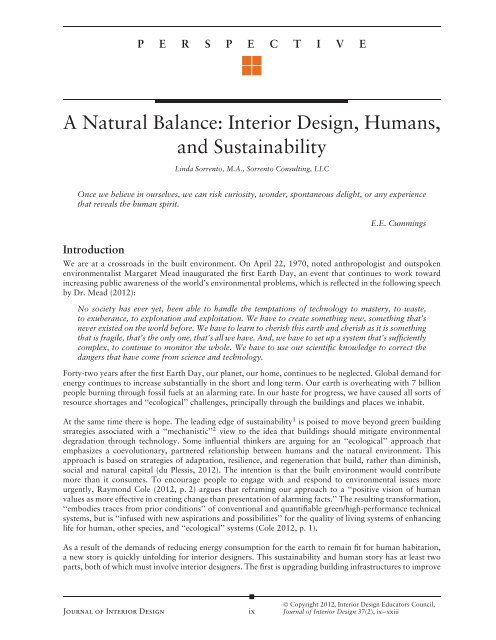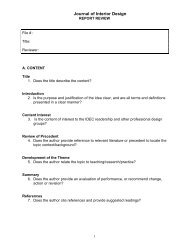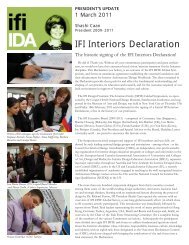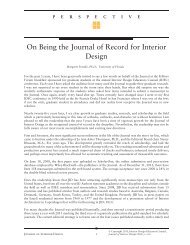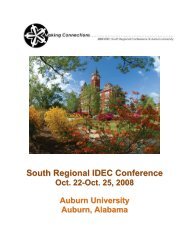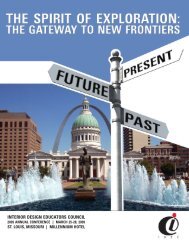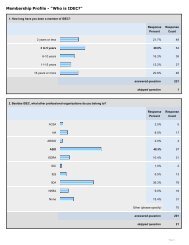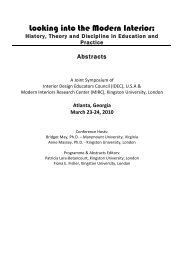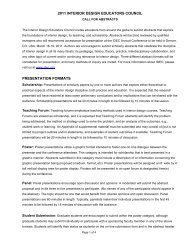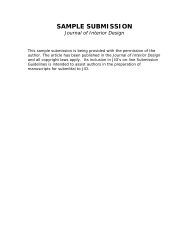A Natural Balance: Interior Design, Humans, and Sustainability
A Natural Balance: Interior Design, Humans, and Sustainability
A Natural Balance: Interior Design, Humans, and Sustainability
You also want an ePaper? Increase the reach of your titles
YUMPU automatically turns print PDFs into web optimized ePapers that Google loves.
P E R S P E C T I V EQualitative data about the actual operational performance <strong>and</strong> its association with designintentions, specific green strategies, <strong>and</strong> human’s physical, neurocognitive, <strong>and</strong>psychosocial response to buildings were, <strong>and</strong> still are, lacking.Clearly, both sides have admirable goals in mind, but are not talking to each other in many cases. Thisdisconnection puts buildings <strong>and</strong> humans at odds with one another. And, it is something that the interiordesigner could help to prevent <strong>and</strong>/or ameliorate, if only more of the stakeholders, including interior designers,would recognize <strong>and</strong> act on this fact.Differing Perspectives Applied to High Performing BuildingsPeople are the legitimate barometer for the built environment; however, our perception of ourenvironment is complex, unrecorded <strong>and</strong> not analyzed.Chris Pyke, Ph.D., Vice President of ResearchU.S. Green Building CouncilEfforts in green building community in the United States have been led by broad interdisciplinary, practitionerledcoalitions seeking to advance design, construction, <strong>and</strong> operation of built environments to promote humanhealth, well-being, <strong>and</strong> the protection <strong>and</strong> restoration of the environment (Pyke, 2012). One discipline thatis often underemphasized here, however, is interior design. Many early practitioners believed that marketinterventions could permanently shift distributions across practices toward higher performance <strong>and</strong> greaterachievement. Certain groups <strong>and</strong> areas, such as real estate, insurance, <strong>and</strong> governmental regulations, connectedearly with green building processes of valuing green performance through quantitative data <strong>and</strong>analysis. However, qualitative data about the actual operational performance <strong>and</strong> its association with designintentions, specific green strategies, <strong>and</strong> human’s physical, neurocognitive, <strong>and</strong> psychosocial response tobuildings were, <strong>and</strong> still are, lacking.Figure 1 shows today’s different practice perspectives across the green building industry as applied to highperformancebuildings. High-performance buildings must fulfill a number of, at times, competing technical(objective) <strong>and</strong> human (subjective) requirements. Figure 1 can be used as a lens for seeing the complexity ofthese agents. It demonstrates that the green building environment consists of many heterogeneous agents withindependent goals, which make sustainability difficult to navigate <strong>and</strong> progress.An important goal for green building practice would be to interrelate these diverse agents in a whole system.The application of the sum of all parts from diverse agents with cohesive interactions can lead to rapidcoevolution toward good high-performance building structures that do not ignore the users. Currently, thebuilding bubbles in Figure 1 are driven by quantitative statistics, which, without qualitative perspectives fromthe occupant bubbles, can reveal misleading tendencies about performance. These agents are maturing atdifferent rates as sized by bubble sizes (a larger circle indicates robust activity <strong>and</strong> the smaller indicates lesseractivity). It appears that the objective, quantitative realm is overtaking qualitative, subjective interpretation.In addition, engineering <strong>and</strong> technology practices are overtaking architecture, interior design, <strong>and</strong> humans.The key in the upper left of Figure 1 will be used as an underlying theme for Figures 1 to 3. The ‘‘Environment’’mechanisms are deployed by the physical elements of the building; ‘‘Behavioral’’ mechanisms are devised byindividual cognitive <strong>and</strong> overt behaviors; <strong>and</strong> ‘‘Social’’ mechanisms are devised by individual cognitive <strong>and</strong>overt behaviors. Conceived by Virginia Kupritz (2000), these elements represent one model to provide humanresources professionals with a template to examine a range of human factors pertinent to their particularsituation. Notice that the behavioral <strong>and</strong> social key bubbles are shown in gray, symbolizing inactive <strong>and</strong>disengaged status for Figure 1.Journal of <strong>Interior</strong> <strong>Design</strong> xi Volume 37 Number 2 2012
P E R S P E C T I V EFigure 1. Different perspectives applied to high-performance buildings describes the drivers behind therelationships of buildings <strong>and</strong> occupants (Pyke, 2011).Reconciling <strong>Humans</strong> <strong>and</strong> Buildings in the Provision of ComfortSince the advent of ‘‘mechanistic’’ buildings in the mid-twentieth century, building inhabitants have becomeincreasingly disconnected from the outdoors. This, coupled with comfort provisioning artificially derived ina laboratory considering only human physiology, created a ‘‘one size fits all’’ thermal comfort. Althoughtechnically correct, these design st<strong>and</strong>ards have been found to be too narrow to be tolerated comfortablyby the building inhabitants. While this conventional practice, with its bias toward a more uniform <strong>and</strong>rigid temperature range, is the norm, not everyone is convinced that this approach is optimal (Nicol,2011). Moreover, this approach focuses only on a single variable—temperature. To actually improve humanhealth <strong>and</strong> well-being, the impact of many variables (health, productivity, satisfaction) within sustainabletechnologies need to be considered. Research in this area, particularly from pioneers Gail Brager, BillBrowning, Judith Heerwagen, <strong>and</strong> Vivian Loftness, is beginning to identify patterns of the multiple kinds ofeffects that green/high-performance buildings have on people (Heerwagen, Gray, & Loder, 2011). They arefinding that a host of cultural, physical, psychosocial, <strong>and</strong> neurocognitive contextual factors shape a person’sengagement with <strong>and</strong> enjoyment of environmental conditions.Journal of <strong>Interior</strong> <strong>Design</strong> xii Volume 37 Number 2 2012
P E R S P E C T I V EFigure 2. Impact of buildings on people illustrates the interrelationships for human-responsive buildings(Heerwagen et al., 2011).As a starting place, Figure 2, adapted from Heerwagen et al. (2011), presents a structure for furtherexploration of the three main areas in which buildings appear to have a consistent effect on people’s physical,psychosocial, <strong>and</strong> neurocognitive functions. Figure 2 shows that when a person’s physical functions arecompromised by a building, it can impact the individual’s cardiovascular <strong>and</strong> respiratory systems, vision,skin, biorhythms, <strong>and</strong> sleep, which can, in turn, increase healthcare costs <strong>and</strong> absenteeism. Furthermore, whena person’s psychosocial functions are compromised by a building, his or her emotional experience, well-being,<strong>and</strong> social supports also can be affected, thus reducing satisfaction <strong>and</strong> engagement with the environment<strong>and</strong> other humans. And finally, when a person’s neurocognitive functions are compromised by a building, itcan impact the individual’s attention, concentration, memory, <strong>and</strong> alertness, which affects productivity. Thekey in the upper left of Figure 2 shows that the ‘‘Environment,’’ ‘‘Behavioral’’ <strong>and</strong> ‘‘Social’’ bubbles are nowin color symbolizing active engaged status for all three mechanisms impacting humans.While many interior designers are aware of at least some of these effects of buildings on inhabitants, mostresearch about these human functions remains discipline specific (usually social sciences) <strong>and</strong> out of reachJournal of <strong>Interior</strong> <strong>Design</strong> xiii Volume 37 Number 2 2012
P E R S P E C T I V EOver the past several years, green building practice has been reframed by adding a fullrange of disciplines with qualitative, broader perspectives, <strong>and</strong> visions such asenvironmental behavior <strong>and</strong> design, biomimicry, biophilia, <strong>and</strong> regenerative design.Figure 3. Integrative thinking for the redefining of the practice of sustainability (Reed, 2012).from the complex array of stakeholders within the built environment (Heerwagen et al., 2011). In the future,greater advancement could be made within a multidisciplinary field, which could sit at the intersectionof science, technology, humans, <strong>and</strong> culture. <strong>Interior</strong> design could <strong>and</strong> should be at the forefront of thatfield. <strong>Interior</strong> designers could help shape how <strong>and</strong> what the researchers in the physical, neurocognitive, <strong>and</strong>psychosocial sciences think about the buildings. And conversely, the research in these areas can help interiordesigners think about human interaction with interior environments, particularly sustainable ones.Integrative Thinking: Reframing <strong>Sustainability</strong>Over the past several years, green building practice has been reframed by adding a full range of disciplineswith qualitative, broader perspectives, <strong>and</strong> visions such as environmental behavior <strong>and</strong> design, biomimicry, 4biophilia, 5 <strong>and</strong> regenerative 6 design (Cole, 2012). Thus, practice has been infused with new aspirations <strong>and</strong>possibilities toward attaining a deeper shade of green. This transition from a ‘‘mechanistic’’ to an ‘‘ecological’’living systems worldview 7 <strong>and</strong> regenerative paradigm is being precipitated by the need for a systems-approachmanner to connect buildings <strong>and</strong> humans. The premise held by du Plessis (2012) <strong>and</strong> others is that thesechanges are necessary for the earth to remain fit for human inhabitation <strong>and</strong> for humans to intelligentlymitigate human impacts.Journal of <strong>Interior</strong> <strong>Design</strong> xiv Volume 37 Number 2 2012
P E R S P E C T I V EThe living systems ’ecological’ worldview is a different way of thinking about, seeing, <strong>and</strong>engaging with the world than those that have dominated green building eco-efficiencyapproaches to sustainability.The living systems ‘‘ecological’’ worldview is a different way of thinking about, seeing, <strong>and</strong> engaging withthe world than those that have dominated green building eco-efficiency approaches to sustainability (Mang& Reed, 2012). Adopting it will require a higher level of interrelationships between natural, human, <strong>and</strong>built systems, <strong>and</strong> the disciplines within them. Boecher et al. (2009, p xiii) describe the achievement of abroader integration of systems within the sustainability movement as an ‘‘integrative design process (IDP) 8 ’’.IDP is emerging as a natural companion to green building practice because it stimulates collaboration amonga diversity of practitioners with different disciplinary backgrounds <strong>and</strong> viewpoints to make human- <strong>and</strong>natural-systems-based connections <strong>and</strong> interrelationships. The term integration means identifying the variety<strong>and</strong> uniqueness of systems <strong>and</strong> connects them into a whole—including human, biotic, <strong>and</strong> earth systems.Boecher et al. (2009) believe that to achieve the health of the whole, we must ask ourselves how the process ofbuilding can be a catalyst for a discovery path that addresses the interrelationships of all living <strong>and</strong> technicalsystems in the service of sustaining the health of all life (p. xiii).Figure 3 conceptually depicts the trajectory of integrative thinking from technical systems design to livingsystems design (Reed, 2012). As the figure indicates, energy reduction is today’s main target of sustainability.However, this target is not simply a mathematic equation with an x/y coordinate system, but a conceptualdepiction with a human/earth responsibility. Some believe the concept in Figure 3 provides the path to truesustainability. The key in the upper left of Figure 3 shows that the ‘‘Environment,’’ ‘‘Behavioral,’’ <strong>and</strong> ‘‘Social’’bubbles are shown in color symbolizing active engaged status for all three mechanisms impacting humans.Researchers find that the data-driven technical systems of conventional <strong>and</strong> green/high-performance designrequire more energy with less occupant engagement for comfort. In contrast, the pattern-driven living systemsof restorative <strong>and</strong> regenerative design require less energy with more human engagement, underst<strong>and</strong>ing, <strong>and</strong>capacity. Realizing this, some of the leaders in sustainability are using the gift of nature to overtake the‘‘machine as a metaphor’’ thinking for sustainability. This is not to say that technology <strong>and</strong> efficiency are notimportant, but it is the underst<strong>and</strong>ing of the role of technology that is important. The target in Figure 3 isenergy reduction without loss of the human factor. Today’s ‘‘mechanistic’’ view may see buildings as machineswithout feelings. In contrast are the ‘‘ecological’’ interrelationships acquainted with human <strong>and</strong> earth systems.Once we realize that technology is not intended to be used as ‘‘man’s dominion over nature,’’ then we canmove our underst<strong>and</strong>ing of technology toward a fusion of nature <strong>and</strong> human spirit. This philosophy canbecome the driving change. The future trajectory is important, but it is even more important that the interiordesigner as user-advocate be in the center of this ‘‘ecological’’ interrelationship bubble, which is decisive fordeeper engagement of humans <strong>and</strong> what is defined as the deepest level of green as we know it.Stories from Practice: United States Green Building HeadquartersEnergy efficiency or human factors alone are not determinates of project success; rather, it is theinterdependence in which each part affects <strong>and</strong> needs each other. When the United States Green BuildingCouncil (USGBC) needed a new headquarters in 2008, slated as one of the first projects to use the latestversion of LEED® for Commercial <strong>Interior</strong>s, the new requirements dem<strong>and</strong>ed the greatest opportunitiesof interdependence for our multidiscipline team to create something that was more than the sum of itsparts, pushing the limits of each profession. At the same time, we hoped to avoid problems of unintendedconsequences, tradeoffs, <strong>and</strong> a single solution by one profession, which could lead to a bigger problem forthe whole. In our project, we discovered that our ideas, inspirations, <strong>and</strong> innovations connected all our teammembers in ways we did not expect.Journal of <strong>Interior</strong> <strong>Design</strong> xv Volume 37 Number 2 2012
P E R S P E C T I V EWe recognized that the most vital <strong>and</strong>, at the same, time viable development grew out ofan underst<strong>and</strong>ing of the occupant experience in <strong>and</strong> around our sustainable interiors.Each aspect <strong>and</strong> step required holistic viewpoints beginning with the USGBC’s desire of market acceptance forsustainability by showcasing sustainable design with a high aesthetic representing an organization (USGBC)that had come of age. Not surprisingly, given the project significance, we had high aspirations for the projectto serve as an active learning opportunity, beginning with the site selection, <strong>and</strong> continuing throughout theproject process <strong>and</strong> the life of the interior. As USGBC’s former director of LEED® for Commercial <strong>Interior</strong>s<strong>and</strong> prime team member representing both the objectives of interior design <strong>and</strong> USGBC’s ideals, I was joinedby a team of creative experts that combined building technology systems (mechanical, structural engineering,<strong>and</strong> information technology) with human systems (lighting, acoustics, biophilia, 9 environmental graphics,<strong>and</strong> ergonomics) bridged by architecture <strong>and</strong> interior design.Our journey began as a small core team—USGBC Chief Operating Officer, real estate broker, architect,engineer, <strong>and</strong> me culling through the best of the few locations in Washington, DC. Some sites were simplynot feasible, worth the energy efficiency improvements, or deficient for human health or well-being. Aftera week, of racing around Washington, DC, we found it! A couple of gutted floors in a 1975 building, thearchitect <strong>and</strong> engineers found the aesthetic <strong>and</strong> energy efficiency potential they needed, <strong>and</strong> I had my humanchecklist covered—near to mass transportation, the staff’s neighborhoods, abundant natural light, views tothe exterior, base building systems that could provide plentiful fresh air, <strong>and</strong> wide column spacing allowingflexibility all lent themselves to healthier <strong>and</strong> better interiors.With the site selected <strong>and</strong> the ‘‘green’’ lease signed, the team engaged in brainstorming iterative madness,evolving what was virtually a blank canvas knowing that while efficient technologies <strong>and</strong> great design were agiven, they were never sufficient. We recognized that the most vital <strong>and</strong>, at the same, time viable developmentgrew out of an underst<strong>and</strong>ing of the occupant experience in <strong>and</strong> around our sustainable interiors. Thefollowing are three examples of our most notable cooperative partnerships for connections, opportunities,<strong>and</strong> innovations to balance <strong>and</strong> harmonize energy efficiency <strong>and</strong> human behavior.The ‘‘Eco-Corridor’’ <strong>and</strong> HVAC SystemCharacterized by light carpet <strong>and</strong> varying temperatures, this 8-ft-wide perimeter next to the full heightwindows brightens the office while significantly curtailing energy consumption. They are shown in Figures 4<strong>and</strong> 6. This was our first white board collaboration initiated by the mechanical engineers when they proposedthe idea—why not make the peripheral areas colder in the winter <strong>and</strong> hotter in the summer? If we zonedthis corridor separately, the heating, ventilation, <strong>and</strong> air-conditioning (HVAC) systems could slash overallenergy consumption by 5%. Immediately, I thought about the workers adjacent to the corridor questioningwhether their comfort was the tradeoff. After I raised the question, everyone agreed we needed to predict ourworkers’ thermo comfort before moving forward. Our modeling showed positive results for achieving energyefficiency while balancing occupant comfort. Yet, while successful on paper, the ideas might not manifestitself as intended, <strong>and</strong>, therefore, flexibility was built into the HVAC system <strong>and</strong> our ‘‘eco-corridor’’ was born(Figures 4 <strong>and</strong> 6).Daylight Management <strong>and</strong> Lighting Power Density ReductionSetting the tone for lighting management, we looked toward strategies to use our best natural resource toenergy reduction—the sun. Refer to Figures 5 <strong>and</strong> 6 for our modeled <strong>and</strong> actual sun angles <strong>and</strong> controls. Oursecond white board collaboration was initiated by the lighting designer when the team proposed setting aJournal of <strong>Interior</strong> <strong>Design</strong> xvi Volume 37 Number 2 2012
P E R S P E C T I V EFigure 4. United States Green Building Council headquarters, Washington, DC: The workspace, energy, &atmosphere eco-corridor <strong>and</strong> HVAC system (Envision <strong>Design</strong>, PLLC, 2009).goal of 50% energy reduction. Okay, we joked, short of issuing miners’ caps to everyone for light, how wouldwe achieve this goal? To accomplish this, we decided to be aggressive in reducing artificial electric lightingthrough active strategies supplemented with passive (free) strategies using natural daylighting. Within ouractive approach, we eliminated artificial ceiling lighting to only use lighting where it was absolutely neededfor work tasks. Ambient foot c<strong>and</strong>les were kept low supplemented by task lighting to raise light levels onlyat work surfaces. Corridors did not have specific dedicated ceiling lighting as the lighting spilled out fromthe perimeter, glass-enclosed offices, or open workspaces. Questioning the comfort tradeoff, I was concernedabout the proximity of the workers to the lower light levels, especially, the workers furthest from the naturaldaylight perimeter. We found that gloomy/bright variances in light levels did have an impact on the user.While important to energy reduction, the active strategies for ambient/task lighting combinations will takefurther study to function appropriately for occupant’s comfort.The passive approach used natural daylighting. Instead of constructing a material-intensive, intrusive lightshelf mounted between columns to bounce daylighting, we used light colored carpet tiles at the perimeter toact as the light shelf shown in Figures 5 <strong>and</strong> 6. This strategy along with other interior design decisions ofplacement, height, <strong>and</strong> color of furniture as well as the light color of the walls, ceilings, <strong>and</strong> floors alloweddeeper penetration of natural light into the interior, which improved natural light levels by over 200% upto 30 ft from the windows. When I raised the question of the comfort tradeoff, we modeled daylighting,plotting the seasonal sun angles to locate the workstations to prevent glare with the height of the workstationpanel. In addition, the motorized shades systems were automatically set to raise <strong>and</strong> lower with the clouds,time of day, <strong>and</strong> season. However, the passive solution was not perfect from the user st<strong>and</strong>point—it as tooksome tweaking, training, <strong>and</strong> behavioral changes for employees to be comfortable. We learned that interiordesign is often underrated for its effect on daylighting. When building designs do not take interior designconsiderations into account early on, the effects of daylighting may be thwarted. This became my job too.Journal of <strong>Interior</strong> <strong>Design</strong> xvii Volume 37 Number 2 2012
P E R S P E C T I V EFigure 5. United States Green Building Council headquarters, Washington, DC: The workspace, energy &atmosphere daylight management <strong>and</strong> lighting power density reduction (Envision <strong>Design</strong>, PLLC, 2009).Advanced Integration of SensorsComfort provisioning <strong>and</strong> control have always been, <strong>and</strong> will remain, a critical performance requirementof buildings (Cole & Brown, 2009). However, according to Cole <strong>and</strong> Brown (2009) ‘‘occupant’s pleasure,comfort <strong>and</strong> productivity are closely linked with their real <strong>and</strong> perceived control over interior environments’’(p. 44). Therefore, sensors can have a significant tradeoff if not closely tied to occupant behavior. We targetedfour key indoor environmental areas for automated control. The daylighting <strong>and</strong> shades are controlled bydaylight-sensing photocells. The thermal/thermostat adjustment, dem<strong>and</strong>-controlled ventilation, acousticaltreatment, <strong>and</strong> dedicated power receptacles are controlled by occupancy sensors. Shades going up <strong>and</strong> down,lights going on <strong>and</strong> off, <strong>and</strong> temperature up <strong>and</strong> down without occupant direct control took a period ofadjustment among the occupants. As predicted by comfort adaptation research, there was a longer period ofpsychological adaptation, occupant underst<strong>and</strong>ing, <strong>and</strong> mechanical adjustment after moving in.Key OutcomesIf you only look at metrics, energy savings have the biggest return on investment <strong>and</strong> the reduction inlighting load is the biggest part of that. The advanced control systems used at USGBC provided quickpayback—included turning off lights when spaces were unoccupied, dimming lights when sun is lighting thespace, adjusting thermostats in unoccupied areas, <strong>and</strong> turning off miscellaneous equipment in unoccupiedspaces. While energy use can be monitored, quantified, <strong>and</strong> managed through the building systems <strong>and</strong>Journal of <strong>Interior</strong> <strong>Design</strong> xviii Volume 37 Number 2 2012
P E R S P E C T I V ENot only was I, the interior designer, an advocate for the users, I also had to be theeducator of the users in the how to make the most of the interiors’ sustainable designelements.Figure 6. United States Green Building Council headquarters, Washington, DC: The perimeter. An‘‘eco-corridor,’’ characterized by light carpet <strong>and</strong> varying temperatures, brightens the office whilesignificantly curtailing energy consumption (Envision <strong>Design</strong>, PLLC, 2009).controls, buildings really do not use energy, people do. While the latter is not entirely true, it is significantenough to warrant using buildings as tools to engage <strong>and</strong> educate in order to build human capabilities towardenergy savings. The space we provided for the people who work <strong>and</strong> visit USGBC is the way our teamworked <strong>and</strong> continues on all fronts. Whether it is use of mass transit or alternative commuting options, notturning on lights when they are not needed, segregating waste streams to make composting possible, usingbike share (instead of a cab), correctly using the occupancy sensor-controlled electric outlets or low-impact,chemical-free pest control techniques, USGBC staff make the most of the opportunities the space affords thembecause they are actively engaged with it. But it did take some education (sometimes tough) on my part asinterior designer to help them learn to accept <strong>and</strong> use the innovations we had incorporated into the interiors.Not only was I, the interior designer, an advocate for the users, I also had to be the educator of the users inthe how to make the most of the interiors’ sustainable design elements.Evolving the Field: Keeping Pace during ChangePeople wish for an easy technical fix that our left brains can underst<strong>and</strong>. But this issue is really abouta change of heart—changing the way we live, not just the way we design buildings.Joel Todd, Chair, LEED Steering CommitteeU.S. Green Building Council (Gould & Hosey, 2007, p. 231)Journal of <strong>Interior</strong> <strong>Design</strong> xix Volume 37 Number 2 2012
P E R S P E C T I V E<strong>Interior</strong> designers must be in the forefront of changing how others in the building <strong>and</strong>sustainability industries see the world <strong>and</strong>, in turn, our work. What happens now is theimportant question for interior designers, educators, <strong>and</strong> students.This Perspective essay has reviewed key concepts in the evolution of sustainability, which are raising thequestions of where <strong>and</strong> how the interior designer’s work fits in. It has shown that interior design has somethingvaluable <strong>and</strong> unique to offer to this new vision of sustainability. But, more important, it emphasizes thatinterior designers must be in the forefront of changing how others in the building <strong>and</strong> sustainability industriessee the world <strong>and</strong>, in turn, our work. What happens now is the important question for interior designers,educators, <strong>and</strong> students.I have shown that approaches to sustainability vary, <strong>and</strong> clearly there is no single correct approach to achievingimproved environmental performance. We have seen that it is also impossible to discuss what constitutessustainability without consideration of the role of the human. This perspective shows that there are competingdem<strong>and</strong>s of buildings versus occupants, in particular in the provision of comfort, health, <strong>and</strong> well-being,while providing <strong>and</strong> maintaining operational efficiencies in energy required. Of course, there have alwaysbeen competing dem<strong>and</strong>s in the built environment, but only recently has there been an urgent need for interiordesigners to seize their role as advocate for the occupants. Given an evolving context for sustainability<strong>and</strong> the broad range of potential stakeholders <strong>and</strong> interpretations, the relationship between interiordesigner <strong>and</strong> sustainability is a continuing <strong>and</strong> unfolding process, <strong>and</strong> one that warrants increasingacknowledgement <strong>and</strong> engagement of interior designers, educators, <strong>and</strong>, more important, students. Thetime is now to put interior design at the forefront of putting occupants first, no matter what approach tosustainability is chosen.As this perspective indicates, there are compelling arguments regarding the need to change current buildingpractice to include new environmental theories, emphases, <strong>and</strong> strategies. For interior designers, this is anopportunity to help guide the future of sustainability toward a more occupant-centered one. If we refuse toget involved or make our case, then some other practitioners or researchers will do it for us. This will meaneducating ourselves about the various approaches to sustainability, including the ‘‘mechanistic,’’ ‘‘ecological,’’<strong>and</strong> everything in between. These competing objectives for interior design likely will require designers toreassess their technical skills <strong>and</strong> psychological <strong>and</strong> cultural literacy. Educators will need to change how toteach students to participate in the integrative design process. Research by interior designers <strong>and</strong> educatorsneeds to be formulated <strong>and</strong> supported to underst<strong>and</strong> complex, cross-disciplinary issues <strong>and</strong> to sustain thisover the long term of evolving sustainable design practice.We also will need to make stronger cases for evidence-based design within the sustainability movement aswe have done in healthcare. Evidence-based design practices can help describe the criteria for sustainability<strong>and</strong> human qualitative measures. While current green practice is premised on measurable quantifiableperformance targets—on perceived certainty in the outcomes, a new ‘‘ecological’’ design approach willrequire ‘‘a qualitatively different type of acceptance by clients <strong>and</strong> stakeholders of a building’s current <strong>and</strong>potential merits’’ (Cole, 2012, p. 5). Client education is a major part of the interior designer’s job description.Here are some ways you can get involved. First, become a resource. As the practice quickly evolves, establishindustry/university collaborative research solutions to provide substantial, holistic, <strong>and</strong> far-sighted researchon interiors. Reach out to nonprofit organizations such as the National Academy of Environmental <strong>Design</strong> 10<strong>and</strong> the USGBC 11 for research resources <strong>and</strong> to develop research skills <strong>and</strong> to learn the specifics aboutsustainability strategies. Engage with your institution for real-time green project experience 12 as your campusplans any construction or improvement projects with an eye on sustainable interiors. Be visible <strong>and</strong> st<strong>and</strong> outin the role of interior designer on these project teams.Journal of <strong>Interior</strong> <strong>Design</strong> xx Volume 37 Number 2 2012
P E R S P E C T I V EAs interior design evolves as a profession, we continue to grapple with identity <strong>and</strong> value. While we ourselvessee the value that we bring to the built environment, others do not. So we are often left out of importantdiscussions around the design table. Our active involvement with sustainability as it struggles to provideenergy efficiency without ignoring the human being can <strong>and</strong> will open doors for us to bring our mostvaluable interior design abilities <strong>and</strong> skills to the discussion—that of a person-centered focus. Of any barriers,constraints, <strong>and</strong> recognition, Penny Bonda, prominent writer, lecturer, <strong>and</strong> founding chair USGBC LEED forCommercial <strong>Interior</strong>s, said in 1994, ‘‘While the LEED system was being developed,’’ she recalls, ‘‘I mentionedthat maybe we should have a version for interiors. One of the [USGBC] board members said, ‘Why? <strong>Interior</strong>sdon’t matter.’ I said ‘Well, actually, that’s where the people are.’’’ (Gould & Hosey, 2007, p. 202).A small group of thoughtful people could change the world. Indeed, it’s the only thing that ever has.Margaret MeadReferencesBoecher, J., Horst, S., Keiter, T., Lau, A., Sheffer, M., Toevs, B., et al. (2009). The integrative design guide to green building: Redefining thepractice of sustainability. Hoboken, NJ: John Wiley & Sons, Inc.Chen, A. (2009). Berkeley Lab: Lawrence Berkeley National Laboratory. Working toward the very low energy consumption building of thefuture. Retrieved January 11, 2012, from http://newscenter.lbl.gov/feature-stories/2009/06/02/working-toward-the-very-low-energyconsumption-building-of-the-future/Choi Granade, H., Creyts, J., Derkach, A., Farese, P., Nyquist, S., & Ostrowski, K. (McKinsey & Company) (2009). Unlocking energyefficiency in the U.S. economy: Executive summary. Retrieved February 1, 2012, from McKinsey & Company website: http://mckinsey.com/USenergyefficiencyCole, R. (2012). Regenerative design <strong>and</strong> development: Current theory <strong>and</strong> practice. Building Research & Information, 40(1), 1–6. RetrievedFebruary 3, 2012, from http://dx.doi.org/10.1080/09613218.2012.617516Cole, R., & Brown, Z. (2009). Reconciling human <strong>and</strong> automated intelligence in the provision of occupant comfort. Intelligent BuildingsInternational, 1(1), 39–55. Retrieved February 3, 2012, from http://dx.doi.org/10.3763/inbi.2009.0007du Plessis, C. (2012). Towards a regenerative paradigm for the built environment. Building Research & Information, 40(1), 7–22.Envision <strong>Design</strong>, PLLC. (<strong>Design</strong>er) (2009). United States Green Building Council Headquarters [Print], Washington, DC.Gould, K., & Hosey, L. (2007). Women in green: Voices of sustainable design in green. Bainbridge Isl<strong>and</strong>, Washington: Ecotone LLC.Heerwagen, J., & Diamond, R. C. (1992). Adaptations <strong>and</strong> coping: Occupant response to discomfort in energy efficient buildings.Proceedings of ACEEE summer study on energy efficiency in buildings, Vol 10, Berkeley, CA, ACEEE, 83–90. Retrieved January 25,2012, from http://epb.lbl.gov/homepages/Rick_Diamond/Coping_aceee_92.pdfHeerwagen, J., Gray, W., & Loder, A. (2011, October). In J. Heerwagen (Chair). Why research matters: New approaches to measuregreen building <strong>and</strong> workers’ health, stress <strong>and</strong> productivity. Paper presented at Greenbuild® conference & expo.Kupritz, V. W. (2000). A conceptual model of privacy regulation for hrd <strong>and</strong> organizations. Journal of Industrial Teacher Education, 38,29–59. Retrieved February 7, 2012, from http://www.cci.utk.edu/node/8929Mang, P., & Reed, B. (2012). <strong>Design</strong>ing from place: A regenerative framework <strong>and</strong> methodology. Building Research & Information, 40(1),23–38. Retrieved February 15, 2012, from http://dx.doi.org/10.1080/09613218.2012.621341Margaret Mead Speaks at First Earth Day. (2012). The History Channel website. Retrieved 1:20, March 3, 2012, fromhttp://www.history.com/audio/margaret-mead-speaks-at-first-earth-day.Nicol, F. (2011). Adaptive comfort. Building Research & Information, 39(2), 105–107.Piedmont-Pall<strong>and</strong>ino, S. (2012, January 26). Interview by L Sorrento [Personal Interview]. Technology <strong>and</strong> human debate.Pyke, C. (2011, August 12). Interview by L. Sorrento [Personal Interview]. Different perspectives applied to high performance buildings.Pyke, C. U.S. Green Building Council (2012). Using information technology to transform the green building market. Washington, DC: U.S.Green Building Council.Journal of <strong>Interior</strong> <strong>Design</strong> xxi Volume 37 Number 2 2012
P E R S P E C T I V EReed, B. (2012, February 23). Interview by L. Sorrento [Personal Interview]. ‘Integrative Thinking’ for the redefining of the practice ofsustainability.Notes1 <strong>Sustainability</strong> here means sustaining life—‘‘a practice by which living things contribute to the interrelationships that ensure the viability ofeach over the long haul’’ (Boecher et al., 2009, p. 42).2 Mechanistic view here means a ‘‘20 th century energy-intensive mechanical systems within buildings that are located remotely fromspaces they served’’ (Cole & Brown, 2009, p. 39).3 ‘‘Green/high-performance design’’ here means to ‘‘realize high efficiency <strong>and</strong> reduced impact in the building structure, operations, <strong>and</strong>site activities. This term can imply a more technical-efficiency approach to design <strong>and</strong> may limit an embrace of the larger natural systembenefits’’ (Boecher et al., 2009, p. 45).4 Biomimicry here means an innovative method that seeks sustainable solutions by emulating nature’s time-tested patterns <strong>and</strong> strategies, forexample, a solar cell inspired by a leaf. The goal is to create products, processes, <strong>and</strong> policies—new ways of living—that are welladapted to life on earth over the long haul. http://www.biomimicryguild.com/guild_biomimicry.html.5 Biophilia here means to design to recognize that the positive experience of natural systems <strong>and</strong> processes in our buildings <strong>and</strong>constructed l<strong>and</strong>scapes is critical to human health, performance, <strong>and</strong> well-being. Biophilic design is about humanity’s place in nature<strong>and</strong> the natural world’s place in human society, where mutuality, respect, <strong>and</strong> enriching relationships can <strong>and</strong> should exist at all levels<strong>and</strong> should emerge as the norm rather than the exception. http://www.biophilicdesign.net/.6 Regenerative design here refers to a ‘‘design process that engages the whole of a system which we are a part. By engaging all the keystakeholders <strong>and</strong> processes of the place-human, earth systems, <strong>and</strong> the consciousness that connects them-the design process builds thecapability of the people to engages in continuous <strong>and</strong> healthy relationship.’’ (Boecher et al., 2009, p. 45).7 Living systems worldview here refers to ‘‘pattern-driven practices that restore <strong>and</strong> regenerate natural systems.’’ (Boecher et al., 2009,p. 45).8 Integrative <strong>Design</strong> Process (IDP) here means ‘‘a discovery process that optimizes—(i.e., makes the best use of, or creates synergybetween)—the interrelationships between all the elements <strong>and</strong> entities that are directly <strong>and</strong> indirectly associated with building projects inthe service of efficient <strong>and</strong> effective use of resources.’’ (Boecher et al., 2009, p. 45).9 Biophilia here means to elements of nature which were included in the space in the form of indoor plants, images of nature, a waterfeature (reception area), natural materials, <strong>and</strong> long distance views to the outside. The images of nature are in the form of photographsprinted on a clear film <strong>and</strong> adhered to the workstation glass panels as shown in Figure 6. In addition, the use of ‘‘natural’’ materials,such as the reclaimed gum wood in lieu of highly refined or clearly man-made materials help evoke the sense of nature.10 National Academy of Environmental <strong>Design</strong>, http://www.naedonline.org/.11 U.S. Green Building Council, Center for Green Schools, Research to Practice Program, http://www.centerforgreenschools.org/r2p2.12 U.S. Green Building Council, Center for Green Schools, Higher Education, http://www.centerforgreenschools.org/green-campus.aspx.Linda Sorrento, FASID, IIDA, LEED AP® BD+CPrincipal Sustainable PracticeSorrento Consulting, LLCA deep concern for how interior environments affect human health <strong>and</strong> performance has informed every facetof Linda Sorrento’s career as a sustainable design advocate, interior designer, researcher, <strong>and</strong> educator. In2011, Linda launched her consulting firm to focus on projects for improving occupant experience in <strong>and</strong>around green buildings. Prior to her consulting practice, Linda was the Senior Director of EducationPartnerships <strong>and</strong> Director of LEED for Commercial <strong>Interior</strong>s for the United States Green Building CouncilJournal of <strong>Interior</strong> <strong>Design</strong> xxii Volume 37 Number 2 2012
P E R S P E C T I V E(USGBC). Linda is a principal developer of REGREEN, the USGBC/ASID green residential renovation <strong>and</strong>interior remodeling program. Linda practiced as a corporate interior designer for 29 years, cultivating adiverse work experience with major corporate clients <strong>and</strong> manufacturers. During that time, she was anassistant professor of interior design at George Washington University <strong>and</strong> Northern Virginia CommunityCollege. Linda is a Fellow of the American Society of <strong>Interior</strong> <strong>Design</strong>ers, past ASID National Board ofDirectors, <strong>and</strong> past ASID Washington Metro Chapter President. She currently serves on the boards of theHealthy Building Network, National Academy of Environmental <strong>Design</strong>, Marymount University RestonCenter <strong>and</strong> Northern Virginia Community College <strong>Interior</strong> <strong>Design</strong> Program. Linda holds a bachelor’sdegree in interior design from Syracuse University <strong>and</strong> a master’s degree in interior design from MarymountUniversity.Journal of <strong>Interior</strong> <strong>Design</strong> xxiii Volume 37 Number 2 2012
Journal of <strong>Interior</strong> <strong>Design</strong> xxiv Volume 37 Number 2 2012


